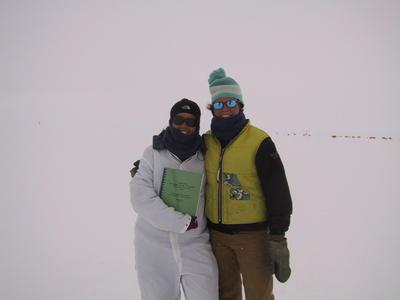10 August, 2001
Preparing for winter
Soon most of us will be leaving, but not all of us. Five hardy souls have
chosen to "winter-over" here at Summit. Kim, Jeff, Tracy, Amy and Peter
will be staying here for the entire winter. They arrived last week and
are spending these last two weeks of the summer season preparing for the
winter.
What does it mean to winter over here?
Why is it necessary?
Why would anyone do it?
What do you have to do to prepare for the winter here?
These were my questions to the group of five who will be staying here
from August 1st to May 1st of next year. This small group of hardy
individuals will have to maintain the camp, conduct the science
experiments and survive any mishaps without outside support until the
Spring. The last flight period into Summit will be in November. At that
time the 109th will bring them their alst shipment of food and supplies,
from then until February 2002, they will be on their own.
Soon, the weather will become excruciatingly cold; temperatures of -50C
with enormous winds and snows. The buildings that they will use will be
the new dorm building and the greenhouse. The big house water supply
will be shut down, The team will cook their own meals, get their own
water and take care of all the science instruments that will be left
here.
Kim, Amy and Peter are the science techs. They have been training with
the summer science techs since they arrived last week. Kim and Amy will
maintain 25 different experiments. Peter, with the Swiss team, will have
his own 5-10 experiments. Each experiment has its own set of
instructions, tools and data collection protocols. There is quite a bit
to learn and maintain. The science tech position is a full time, 8 hours
a day, 6 days a week, job. Tracy and Jeff will maintain the generators,
groom the runway, keep the heat, lights and water life support systems
going.
There are some special precautions that one must take to spend the winter
in such a remote and inaccessible place. The team will have food for
many more months than they anticipate needing. Each time a flight has
arrived at Summit this summer, more fuel and rations have been
stockpiled. In case the generator fails, there are batteries, Coleman
portable stoves and lamps. In fact, today from 5-8 pm, we had no power.
This allowed the team put a new generator on line and test the system for
the winter. As we moved about camp without the humm of the generators,
pumps, fans and lights, it was almost eerie realizing how frail we are
without the power source of the generators. Of course, in my inevitable
curious mind I began constructing a "what if" scenario? What if the power
does not return? How will we survive without power, heat or water? I was
confident we'd work it out but for how long and what would we all do?
Would we be rescued? This experience made me realize what a challenge
these 5 folks are taking on. It made me all the more appreciative of
their courage and fortitude.
The team are all versatile people. Some have wilderness first aid
skills, can suture wounds and start IV's. Kim is an expert cook. Tracy
and Jeff both know how to operate the generator, drive the big machines
and fix just about anything. All have spent time in remote places before,
but this is their first winter at Summit.
When I asked Jeff and Tracy why they were doing this, both said they were
looking forward to the challenge and the adventure. Tracy likened it to
being on a space ship or Mars. They will certainly have some stories to
tell when they return.
Tomorrow, the team will drag a weather port, or small shelter that is
like a tent out to the most remote point that they travel to in the
winter. There, 12 km from here, they will leave a set of survival gear in
case they are trapped out there by mechanical failure or weather. I hope
to go along on the adventure to see how this is done.

The winter over crew meeting for the first time in Kangerlussag this summer. From the left: Jeff, Kim, Peter, Amy and Tracy

Amy (with the book) and Meg preparing for the winter science. Amy will take Meg's place. Meg has been here since May. There are 25 different science experiments the techs take care of.
Contact the TEA in the field at
.
If you cannot connect through your browser, copy the
TEA's e-mail address in the "To:" line of
your favorite e-mail package.
|
